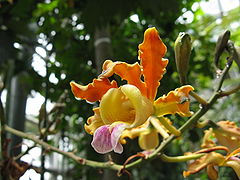Difference between revisions of "Myrmecophila tibicinis"
| Line 27: | Line 27: | ||
|usda_ref=Flora - A Gardener's Encyclopedia | |usda_ref=Flora - A Gardener's Encyclopedia | ||
|max_zone=12 | |max_zone=12 | ||
| − | |image= | + | |image=Schomburgkia tibicinis1.jpg |
|image_width=240 | |image_width=240 | ||
| + | |image_caption=Myrmecophila tibicinis | ||
}} | }} | ||
Describe plant here... | Describe plant here... | ||
Latest revision as of 13:29, 22 May 2010
| Habit | orchid
| |
|---|---|---|
| Height: | ⇕ | 1 ft"ft" can not be assigned to a declared number type with value 1. to 8 ft"ft" can not be assigned to a declared number type with value 8. |
| Width: | ⇔ | 1 ft"ft" can not be assigned to a declared number type with value 1. to 3 ft"ft" can not be assigned to a declared number type with value 3. |
| Lifespan: | ⌛ | perennial |
| Bloom: | ❀ | early summer, mid summer, late summer |
| Exposure: | ☼ | sun, part-sun |
|---|---|---|
| Features: | ✓ | flowers |
| USDA Zones: | 11 to 12 | |
| Flower features: | ❀ | red, orange, yellow, pink |
Describe plant here...
Read about Myrmecophila tibicinis in the Standard Cyclopedia of Horticulture
|
|---|
|
Schomburgkia tibicinis, Batem. (Epidendrum tibicinis, Batem.). Pseudobulbs 1-1 1/2 ft. long, tapering upward: lvs. 2-3, oblong, leathery: raceme 4-8 ft. high, bearing numerous fls. each 3 1/2 in. across; sepals and petals oblong, undulate, crisp; lateral lobes of the labellum large, cucullate, middle lobe small, emarginate; fls. deep pink, speckled with white on the outside, rich chocolate-red within; labellum white within, deep rose- color at the sides, with a short chocolate-red middle lobe. Summer. Honduras, Cuba. Var. grandiflora, Lindl. Fls. larger and paler, with more yellow in the lip.— S. tibicinis requires less compost than the other species. CH
|
Cultivation
Propagation
Pests and diseases
Varieties
Gallery
References
- Standard Cyclopedia of Horticulture, by L. H. Bailey, MacMillan Co., 1963
External links
- w:Myrmecophila tibicinis. Some of the material on this page may be from Wikipedia, under the Creative Commons license.
- Myrmecophila tibicinis QR Code (Size 50, 100, 200, 500)

